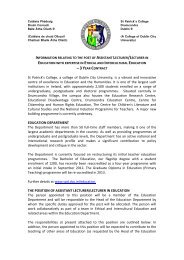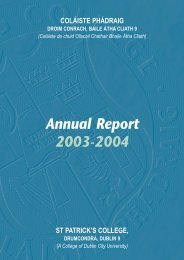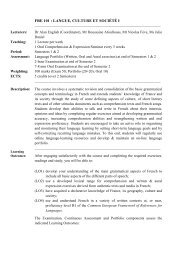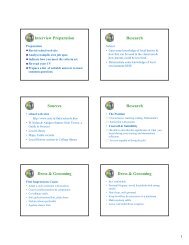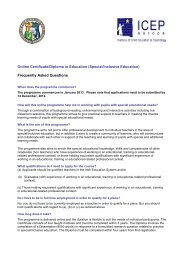You also want an ePaper? Increase the reach of your titles
YUMPU automatically turns print PDFs into web optimized ePapers that Google loves.
<strong>St</strong> Patrick’s <strong>College</strong>, Drumcondra<br />
<strong>St</strong>yle Sheet<br />
Introduction:<br />
This style sheet is designed to help students prepare essays, dissertations and other written<br />
assignments for the English Department. An academic essay is a formal piece of writing,<br />
which means that it must adhere to certain standards in style, layout and presentation.<br />
Appropriate presentation is one of the most important elements considered when grading<br />
essays, project work and theses. Good organisation, a clear plan, attention to paragraphs and<br />
clear expression are all of paramount importance. The style sheet will help students when<br />
they quote from literary texts, acknowledge debts to outside sources, and revise their drafts<br />
for final submission.<br />
1. Designating Titles:<br />
Conventions exist in designating titles so that it is easier for a reader to understand which<br />
type of work you are discussing. If you are discussing Hamlet, for example, then we know<br />
you are discussing the play, not the character, because titles are usually italicised. Similarly,<br />
if we know that James Joyce wrote short stories as well as novels then we can assume that<br />
‘The Dead’ is a short story and Ulysses is a novel.<br />
When an essay is typed use italics for titles; when hand-written underline the titles:<br />
• Titles of plays: Hamlet; King Lear<br />
• Collections of short stories: Dubliners; Wise Blood<br />
• Collections of poetry: Daddy, Daddy; Life <strong>St</strong>udies<br />
• Books of criticism: Orientalism; Culture and Empire<br />
Use single quotation marks for the following:<br />
• The titles of poems: ‘Easter 1916’ or ‘No Second Troy’<br />
• Short <strong>St</strong>ories: ‘Araby’ or ‘The Dead’<br />
• Articles appearing in journals or in collections of essays: ‘Where Green is Read’ or ‘The<br />
Subjectivity of Science Fiction’<br />
Quotations:<br />
Check all quotations for accuracy and make sure that you reproduce original sources exactly.<br />
a) Prose:
If you are quoting a small amount (no longer than four lines), simply include this in the text<br />
with single quotation marks around the quoted portion:<br />
Example<br />
Joseph Conrad writes of the company manager in Heart of Darkness, ‘He was obeyed,<br />
yet he inspired neither love nor fear, nor even respect.’<br />
For a longer quotation (longer than four lines), indent the left-hand side of the line, as you<br />
would for a new paragraph. When you indent, do not use quotation marks.<br />
Example<br />
At the conclusion of Lord of the Flies, Ralph and the other boys realise the horror of<br />
their actions:<br />
The tears began to flow and sobs shook him. He gave himself up to them now for<br />
the first time on the island; great, shuddering spasms of grief that seemed to<br />
wrench his whole body. His voice rose under the black smoke before the burning<br />
wreckage of the island; and infected by that emotion, the other little boys began<br />
to shake and sob too.<br />
b) Poetry:<br />
If you are quoting no more than 3 lines, there is no need to indent; simply place the quotation<br />
in the body of the text as with any other quotation. If there is a line break, signal this with a<br />
slash (/).<br />
Example<br />
Eavan Boland wrote ‘The only legend I have ever loved is/ the story of a daughter lost<br />
in hell.’<br />
When you quote more than three lines, indent the left-hand side of the line, just as you would<br />
for a new paragraph. Make sure that you quote accurately, paying special attention to the<br />
ends of lines and the use of capitals.<br />
Example<br />
Elizabeth Bishop’s ‘In the Waiting Room’ is rich in evocative detail:<br />
It was winter. It got dark<br />
Early. The waiting room<br />
Was full of grown-up people,<br />
Arctics and overcoats,<br />
Lamps and magazines.<br />
c) Drama:
The same rules on length apply here as with poetry and prose (above). However, if quoting<br />
dialogue between two or more characters, you must indent the quotation, supplying the<br />
characters’ names followed by a full stop.<br />
Example<br />
IAGO. Ha! I like not that.<br />
OTH. What dost thou say?<br />
IAGO. Nothing my lord; or if I know not what. (3.3.34-36)<br />
Always include act, scene and line numbers in your citation in the form indicated above.<br />
d) Ellipsis:<br />
Whenever you wish to omit something from a quotation, perhaps because it is less relevant to<br />
your argument, indicate this in the text using ellipsis (three or four dots). The intentional<br />
omission of some words from the quoted passage is indicated by three dots. Four dots<br />
indicates that the omission includes a full sentence.<br />
Example<br />
‘“Among School Children” is the poem to read…to see how vivid the tension between<br />
history and symbol can be….The same may be said of “Leda and the Swan”.’<br />
Note that here the two poem titles are given double quotation marks as the entire sentence is<br />
itself a direct quotation. Use the same system when you have a ‘quote within a quote’: the<br />
inner quote takes double quotation marks, and the outer quote takes single. Indented<br />
material, as in the examples in a) and b) above, is not enclosed in quotation marks; however<br />
if there is a direct quote (or direct speech) within the indented material then single quotation<br />
marks should be used.<br />
3. Systems of Citation:<br />
CITING means formally recognising, within your text, the resources from which you have<br />
obtained information.<br />
While an essay should primarily reflect your own ideas in your own words, it is acceptable<br />
and sometimes even necessary to refer to the works of critics. The proper acknowledgement<br />
of sources for quotations you have used is of crucial importance in writing essays and<br />
dissertations. Failure to acknowledge a source could open you to a charge of plagiarism,<br />
even if you have been merely careless. (See section on plagiarism) To avoid plagiarism, do<br />
not think you have to be entirely original and not read anything anyone else has written. Just<br />
remember that you must quote and cite your sources accurately and honestly. Quotation must<br />
support, not make your argument. There are many acceptable forms of citation (the<br />
parenthetical method, footnotes or endnotes etc.); however, the parenthetical method should<br />
be used for all undergraduate work submitted to the English Department in <strong>St</strong> Patrick’s. The<br />
rule is: always be consistent.
The parenthetical method is the most straightforward, because initially all you need to do is<br />
mention the author, date of publication and page in the text of your work. You key this<br />
citation to an alphabetical list of works that appears at the end of the paper (see<br />
Bibliography).<br />
Example<br />
(Author, Year, Page)<br />
‘Gramsci makes a key distinction between intellectual activity and intellectuals.’<br />
(O’Dowd, 1996, 9)<br />
When the author is already mentioned in the sentence, the name may be omitted in the<br />
parenthesis.<br />
Example<br />
Smyth comments on the need to address political and cultural activity in the modern<br />
period. (1998, 9)<br />
The reader can easily locate the full description of the item you have cited by referring to the<br />
alphabetical bibliography provided at the end of your essay:<br />
Example<br />
Smyth, Gerry. Decolonisation and Criticism. London: Pluto, 1998.<br />
(i)<br />
Bibliography (List of Works Cited):<br />
A BIBLIOGRAPHY is the list of sources you have used.<br />
A REFERENCE is the detailed description of the item from which you have obtained your<br />
information.<br />
Every essay should have a bibliography. This should be ready before you write your essay so<br />
that you can use it to give sources for your citations. The bibliography should include all the<br />
works from which you have quoted, and all of the works you have consulted and from which<br />
you have gained useful information in the preparation of your essay, including any web<br />
material. Although you may not directly quote from all the sources and merely paraphrase or<br />
use their ideas, it is very important to include the source in your bibliography. List works<br />
under the author’s name (surname), in alphabetical order and include at the end of your essay.<br />
Use the author’s name as it appears on the title page (note also the correct use of punctuation<br />
marks in the examples below).<br />
(ii)<br />
The Basic Entry: A Book by a Single Author:<br />
Example<br />
(Author. Title of the Book. City of Publication: Publisher, Year of Publication.)<br />
Morrison, Toni. Beloved. London: Pan Books, 1988.<br />
Unterecker, John. A Reader’s Guide to W.B. Yeats. London: Thames and Hudson, 1967.
(iii)<br />
An Anthology:<br />
To cite an anthology, begin your entry with the name of the editor, followed by a comma and<br />
the abbreviation ‘ed.’<br />
Example<br />
Feldman, Paul R., ed. British Women Poets of the Romantic Era. Baltimore: John Hopkins<br />
UP, 1997.<br />
(iv) A Book by Two or More Authors:<br />
To cite a book by two or three authors, give their names in the same order as on the title page,<br />
not necessarily in alphabetical order. Reverse only the name of the first author, add a<br />
comma, and give the other name or names in normal form. Place a full stop after the last<br />
name.<br />
Example<br />
Eggins, Suzanne, and Diane Slade. Analysing Casual Conversation. London: Cassell, 1997.<br />
(v)<br />
Two or More Books by the Same Authors:<br />
To cite two or more books by the same authors, give the names in the first entry only.<br />
Thereafter, in place of the names, type three dashes, followed by a full stop and the title. The<br />
three dashes stand for exactly the same names as in the preceding entry.<br />
Example<br />
Durant, Will, and Ariel Durant. The Age of Voltaire. New York: Simon, 1965.<br />
---, A Dual Autobiography. New York: Simon, 1977.<br />
(vi)<br />
A Work in an Anthology:<br />
If you are citing an essay, a short story, a poem or another work that appears within an<br />
anthology or some other book collection, you need to add the following information to the<br />
basic book entry:<br />
Author, title, and (if relevant) translator of the part of the book being cited. Begin the entry<br />
with the author and title of the piece, normally enclosing the title in single quotation marks.<br />
Add the page numbers of the piece.<br />
Example<br />
Allende, Isabel. ‘Toad’s Mouth.’ Trans. Margaret Sayers Peden. A Hammock Beneath<br />
the Mangoes: <strong>St</strong>ories from Latin America. Ed. Thomas Colchie. New York: Plums, 1992.<br />
83-88.<br />
Hansberry, Lorraine. ‘A Raisin in the Sun’. Black Theater: A Twentieth-Century<br />
Collection of the Work of Its Best Playwrights. Ed. Lindsay Patterson. New York: Dodd,<br />
1971. 221-78.
(vii)<br />
An Article in a Reference Book:<br />
Example<br />
‘Ginsburg, Ruth Bader.’ Who’s Who in America. 52 nd ed. 1998.<br />
‘Noon.’ The Oxford English Dictionary. 2 nd ed. 1989.<br />
(viii) A Book Published in a Second or Subsequent Edition:<br />
Where there is a gap between the first and subsequent editions, list both. Unless informed<br />
otherwise, readers assume that bibliographic entries refer to first editions. When you use a<br />
later edition of a work, identify the edition in your entry by number (2 nd ed., 3 rd ed., 4 th ed.)<br />
by name ( Rev. ed., for ‘revised edition’).<br />
Example<br />
Chaucer, Geoffrey. The Works of Geoffrey Chaucer. Ed. F.W. Robinson. 2 nd ed. Boston:<br />
Houghton, 1957.<br />
(ix)<br />
An Article in a Scholarly Journal:<br />
Example<br />
(Author’s Name. ‘Title of the Article.’ Publication Information and page nos.)<br />
Most, Andrea. ‘“We Know We Belong to the Land”: The Theatricality of Assimilation in<br />
Rodgers and Hammerstein’s Oklahoma!’’ PMLA 113 (1998): 77-89.<br />
(x)<br />
A Film or Video Recording:<br />
A film entry usually begins with the title italicised (if typed) or underlined (if hand-written),<br />
and includes the director, the distributor, and the year of release. You may include other data<br />
that seems pertinent, such as the names of the writer, performers, and producer between the<br />
title and the distributor. If the film has been reissued, also cite the year of reissue.<br />
Example<br />
It’s a Wonderful Life. Dir. Frank Capra. Perf. James <strong>St</strong>ewart, Donna Reed, Lionel<br />
Barrymore and Thomas Mitchell. RKO, 1946.<br />
(xi)<br />
A Performance:<br />
An entry for a performance (play, opera, ballet, concert) usually begins with the title, contains<br />
facts similar to those given for a film and concludes with the site of the performance (usually<br />
the theatre and city, separated by a comma and followed by a full stop) and the date of the<br />
performance.<br />
Example<br />
Hamlet. By William Shakespeare. Dir. John Gielgud. Perf. Richard Burton. Shubert<br />
Theatre, Boston. 4 Mar. 1964.
(xii) An Interview:<br />
To cite an interview that you conducted, give the name of the person interviewed the kind of<br />
interview (personal interview, telephone interview) and the date.<br />
Example<br />
Banville, John. Personal Interview. 22 July 1993.<br />
(xiii) A Lecture, A Speech, An Address, or A Reading:<br />
In a citation of an oral presentation, give the speaker’s name; the title of the presentation (if<br />
known) in quotation marks; the meeting and the sponsoring organisation (if applicable); the<br />
location; and the date. If there is no title, use an appropriate descriptive label (address,<br />
lecture, keynote speech, reading). Neither should be underlined or enclosed in quotation<br />
marks.<br />
Example<br />
Atwood, Margaret. ‘Silencing the Scream’. Boundaries of the Imagination Forum. MLA<br />
Convention. Royal York Hotel, Toronto. 29 Dec. 1993.<br />
( xiv) Electronic Publications:<br />
To cite files available on the electronic media, use the following items in this order when<br />
available: author, title (italicised if typed, underlined if hand-written), institution or<br />
organisation associated with the site, date of access, and the URL (in single brackets). If you<br />
cann ot find some of this information, cite what is available.<br />
Examp<br />
le<br />
Romantic Chronology. Ed. Laura Mandell and Alan Liu. Nov. 1997. U of California, Santa<br />
Barbara. 22 June 1998 http://humanitas.ucsb.edu/projects/pack/rom-chrono/chrono.<br />
Html.<br />
4. <strong>St</strong>yle:<br />
• Watch spelling, capitalisation, paragraphing and syntax.<br />
• Essays should have an introduction, and a conclusion that draws together your arguments.<br />
• Always write a draft; always proofread your essays.<br />
• Spacing: double space throughout, with the following exception: any indented quotation<br />
separated from the text should be single-spaced.<br />
• Avoid sexist language where possible.<br />
a) Possessive Apostrophe Using a Proper Name:<br />
Form the possessive of the monosyllabic proper names ending in s or another sibilant by<br />
adding an apostrophe and s:
Example<br />
Keats’s<br />
Tess’s<br />
Yeats’s<br />
Marx’s<br />
More than one syllable ending in s or a sibilant, add the apostrophe only:<br />
Example<br />
Hopkins’<br />
b) Beginning of a Paraphrase:<br />
If you are paraphrasing, always show where the paraphrase begins in the text.<br />
Example<br />
According to Kitto, the Greeks were moderate men. (Kitto, 1960, 112)<br />
If you are writing an essay on a single text, put a shortened title and page number at the end<br />
of a quotation (Heart of Darkness can be rendered as Heart, for example) and include the full<br />
biographical details in your bibliography:<br />
Example<br />
‘The Nellie, a cruising yawl, swung to her anchor without a flutter of the sails, and was<br />
at rest.’ (Heart, 27)<br />
English Department, SPD, 2011.









